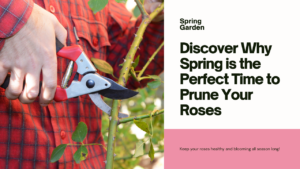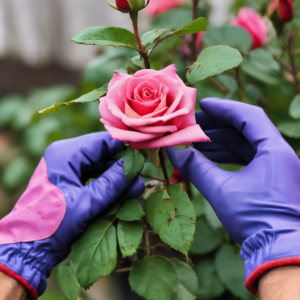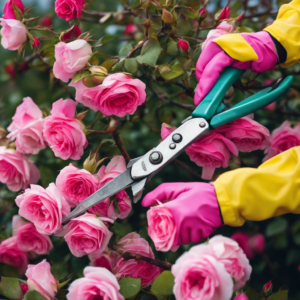
Spring is the ideal season to take care of your beloved roses. Pruning your roses during this time promotes healthy growth and ensures that they produce vibrant blooms throughout the season. Don’t wait any longer – grab your gardening gloves and pruning shears and get to work!
Pruning roses in spring may seem daunting, but it’s a simple and essential practice that every gardener should adopt. In this article, we’ll guide you through the basics of pruning, timing your pruning for optimal growth and blooming, removing dead and damaged wood, shaping and training your roses, encouraging proper growth, feeding and watering your roses after pruning, and protecting your roses from pests and diseases.
Key Takeaways
- Pruning your roses in spring promotes healthy growth and ensures they produce vibrant blooms throughout the season.
- Timing your pruning is essential for optimal growth and blooming potential.
- Removing dead and damaged wood from your roses is crucial to encouraging proper growth and vibrant blooms.
- Shaping and training your roses can create an aesthetically pleasing rose bush.
- Proper feeding and watering after pruning are critical for rose recovery and growth.
Understanding the Basics of Pruning
Pruning is an essential part of maintaining healthy and vibrant rose bushes. Understanding the basics of pruning is key to promoting optimal growth and blooming in your roses. In this section, we will cover the fundamental principles of pruning and the techniques that will help you achieve this goal.
The first step in pruning roses is having the right tools. You will need a pair of sharp, bypass pruning shears, long-handled lopping shears for thicker branches, and pruning saws for larger pruning tasks. For effective results, it is crucial to keep your tools clean and sharp by regularly wiping them with alcohol and lubricating the movable parts.
The second step is to learn the proper technique for pruning. The best way to start is to begin with dead or damaged wood, as this type of wood will inhibit the healthy growth of your roses. With your pruning shears, make a clean cut at a 45-degree angle, just above the bud. This technique helps to keep water from settling on the bud and encourages optimal regrowth. Avoid cutting too close to the bud or leaving a stub or straggly end that can be a breeding ground for pests and diseases.
Once you have removed all dead and damaged wood, it’s time to move on to shaping and training. At this stage, you should be looking to develop a framework of well-spaced and well-positioned canes that will support vibrant blooms. A common technique is to use a sharp pruning saw to cut back the branches to a height of 18 inches above the ground.
Remember to always prune above a bud that faces outward from the center of the plant so that the new growth will direct the plant’s energy outward, encouraging healthy air circulation around the bush. Don’t worry if you remove too much wood at first; your rose bushes are highly resilient and will regrow with appropriate care and nurturing.
With these basics in mind, you’re ready to begin pruning your roses to promote healthy growth and vibrant blooms. Stay tuned for more tips and techniques in the following sections.
Timing Your Pruning for Maximum Results
If you want to see your roses grow and bloom to their full potential, timing is everything when it comes to pruning. The optimal time for pruning your roses is during early spring when the weather starts to warm up.
The best way to determine the perfect timing for pruning is to look for specific signs. A general rule is to prune your roses once the leaf buds start to swell. This indicates that the roses are transitioning from a dormant state to an active growth cycle.
Pruning during this time encourages optimal growth, as the plants have a full growing season ahead to recover and develop new growth. Pruning later in the season can lead to stunted growth and fewer blooms.
Pruning Tips for Maximum Results
When pruning your roses, it is important to use the right tools and techniques to avoid damaging the plant. Here are some tips to keep in mind:
- Use sharp and clean pruning shears or loppers to make clean cuts and prevent the spread of diseases.
- Prune at a 45-degree angle to promote healing and reduce the risk of disease.
- Remove any dead or damaged wood to encourage new growth and prevent the spread of pests and diseases.
- Prune to create an open-centered shape to promote good air circulation and sunlight exposure.
By following these tips and ensuring you are pruning at the right time, you can help your roses achieve maximum growth and blooming potential.
Removing Dead and Damaged Wood

During pruning, it is essential to remove any dead or damaged wood from your roses. These branches can attract pests and disease and inhibit the healthy growth of your plant. Removing them allows the plant to use its energy more efficiently, resulting in optimal growth and vibrant blooms throughout the season.
To identify dead wood, look for branches that have no green leaves or growth. Damaged wood may be discolored or have scars from previous injuries. Use sharp shears or pruners to make clean cuts at a 45-degree angle, removing the wood back to healthy tissue.
When approaching thicker branches, use a saw and make a clean cut at the base of the branch. Avoid leaving any jagged edges that can lead to insect infestation.
Tip: Avoid pruning during wet weather, as this can increase the risk of disease spread. After pruning, be sure to sanitize your tools with a solution of bleach and water to prevent the spread of any remaining disease or pests.
Shaping and Training Your Roses
Transforming your rose bush into an aesthetically pleasing work of art is an art form in itself. With the right techniques and tips, you can shape and train your roses to achieve the desired forms and styles.
To get started with shaping and training your roses, you should begin by selecting the right branches and stems to keep. Look for healthy, strong, and well-spaced branches, and remove any dead or weak stems.
Next, decide on the shape you want to create. Common rose bush shapes include the standard, the upright, and the spreading. Then, use your pruning shears to shape the top and sides of the bush, cutting at a slight angle just above the bud. Remember to only remove about 1/3 of the growth at any one time to avoid harming your rose bush.
In addition to shaping, you can also train your rose bush to grow in a specific direction or form. Use stakes or trellises to guide your branches and stems. Tie the branches loosely to avoid damaging them as they grow.
Finally, don’t be afraid to experiment with different shapes and forms to find the style that works best for your garden. Whether you’re aiming for a classic topiary shape or a more whimsical shape, shaping and training your roses is a fun and rewarding way to add beauty to your outdoor space.
Encouraging Proper Growth with Pruning

Pruning is a vital tool in promoting proper growth and health for your roses. By removing dead, diseased, or damaged wood, you reduce the risk of infection and encourage new growth. Additionally, pruning can stimulate the production of lateral shoots, which will create a fuller, more robust plant.
Caring for pruned roses is an ongoing process, and it’s important to continue to monitor your plants after trimming to ensure they continue to prosper. Watering and fertilizing are crucial steps in the post-pruning process, as they provide the necessary nutrients for growth.
Tip: Avoid over-fertilizing, as this can lead to excessive growth and weaker branches.
Proper planting is also essential for encouraging optimal growth. Make sure to plant your roses in well-draining soil and in an area that receives at least six hours of sunlight per day.
“Proper pruning encourages plants to grow strong and healthy, and allows them to focus their energy on producing beautiful blooms.”
Feeding and Watering Your Roses After Pruning
Properly feeding and watering your roses after pruning is essential for their growth and recovery. During the post-pruning phase, your roses need extra care and attention to support their health and encourage new growth.
When it comes to feeding your roses, choose a high-quality fertilizer that contains essential nutrients such as nitrogen, phosphorus, and potassium. Apply the fertilizer according to the instructions provided and avoid over-fertilizing as it can damage your plants.
Additionally, make sure to water your roses deeply and regularly to prevent them from drying out and to encourage root growth. The amount of water your roses need depends on factors such as climate, soil type, and plant size. However, a good rule of thumb is to water your roses deeply once a week or more often during hot and dry weather.
Remember, proper feeding and watering practices are crucial for post-pruning care. By providing your roses with the essential nutrients and water they need, you can help them recover quickly and thrive throughout the season.
Protecting Your Roses from Pests and Diseases
Keeping your roses healthy and vibrant requires protecting them from common pests and diseases. Fortunately, with the right pest control measures, you can ensure your roses remain pest-free and disease-resistant.
Start by inspecting your roses regularly for signs of pests and diseases, such as holes in the leaves, yellowing leaves, or black spotting. Early detection is key to preventing an infestation.
When it comes to pest control, you have two main options: organic and chemical. Organic pest control involves using natural methods to deter pests, such as companion planting, neem oil, or insecticidal soap. Chemical pest control involves using synthetic pesticides to kill pests.
While chemical pesticides can be effective, they also come with risks, such as harming beneficial insects and impacting the environment. It’s important to use them sparingly and only as a last resort.
Tip: The best way to discourage pests is to encourage beneficial insects, such as ladybugs and lacewings, to your garden. You can do this by planting pollinator-friendly plants and avoiding pesticides that harm these insects.
In addition to pest control, you can also take preventative measures to keep your roses disease-resistant. This includes keeping the area around your roses clean and free of debris, pruning regularly to promote air circulation, and planting disease-resistant rose varieties.
FAQ
Q. Why is spring the best time to prune roses?
A. Spring is the ideal time to prune roses because it promotes new growth and encourages them to bloom. Pruning in spring removes dead wood and stimulates healthy growth, resulting in vibrant and abundant flowers.
Q. What are the benefits of pruning roses in spring?
A. Pruning roses in spring improves their overall health and appearance. It helps remove diseased or damaged wood, encourages proper growth, and enhances blooming. Pruning also allows for shaping and training of the roses to create an aesthetically pleasing bush.
Q. How do I understand the basics of pruning roses?
A. Understanding the basics of pruning is essential for successful rose care. You will learn the proper techniques, tools needed, and step-by-step instructions for beginners to ensure healthy growth and beautiful blooms.
Q. When is the best time to prune roses in spring?
A. The best time to prune roses in spring is when the buds begin to swell, but before new growth emerges. Look for signs of dormancy break and prune before the leaves fully unfurl for maximum results.
Q. Why is it important to remove dead and damaged wood during pruning?
A. Removing dead and damaged wood during pruning is crucial for optimal growth and vibrant blooms. Deadwood can be a breeding ground for pests and diseases, and pruning it helps redirect the plant’s energy into healthy growth and flower production.
Q. How can I shape and train my roses for an aesthetically pleasing bush?
A. Shaping and training roses allows you to create visually appealing forms and structures. You can use pruning techniques to shape and control the growth of your roses, promoting a balanced and well-proportioned bush.
Q. How does pruning encourage proper growth in roses?
A. Pruning encourages proper growth in roses by removing weak or overcrowded branches, allowing more air circulation and sunlight penetration. This helps prevent diseases and promotes healthy growth of new stems and blooms.
Q. What are the essential post-pruning care practices for roses?
A. After pruning, it’s important to feed and water your roses properly. They require adequate nutrients to recover and grow, so provide them with a balanced fertilizer and regular watering to keep the soil moist.
Q. How can I protect my roses from pests and diseases?
A. To protect your roses from pests and diseases, practice good garden hygiene by removing fallen leaves and debris. Additionally, you can use organic or chemical pest control methods, and regularly inspect your plants for signs of infestation or disease.
Q. What are the key takeaways from this article on spring rose pruning?
A. The importance of spring pruning for beautiful roses cannot be overstated. Pruning promotes healthy growth, blooming, and shapes the bush. Remember to maintain your pruned roses throughout the year with regular care and attention to ensure their continued health and beauty.
Conclusion
Now that you understand the importance of spring pruning for beautiful, healthy roses, it’s up to you to maintain them throughout the year. Remember to prune your roses regularly and remove any dead or damaged wood for optimal growth and vibrant blooms.
Use the right tools and timing to prune your roses effectively. Encourage proper growth by shaping and training your roses, as well as providing them with proper feeding and watering after pruning.
Protect your roses from pests and diseases by using organic or chemical pest control methods and preventative measures to keep them healthy and strong.
By maintaining your pruned roses with care and attention, you can enjoy their beauty and fragrance for years to come. So, get out there and start pruning your roses today!
















